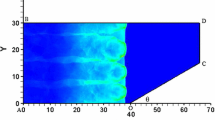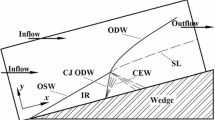Abstract
The Mach reflection of cellular detonation waves on a wedge is investigated numerically in an attempt to elucidate the effect of cellular instabilities on Mach reflection, the dependence of self-similarity on the thickness of a detonation wave, and the initial development of the Mach stem near the wedge apex. A two-step chain-branching reaction model is used to give a thermally neutral induction zone followed by a chemical reaction zone for the detonation wave. A sufficiently large distance of travel of the Mach stem is computed to observe the asymptotic behavior in the far field. Depending on the scale at which the Mach reflection process occurs, it is found that the Mach reflection of a cellular detonation behaves essentially in the same way as a planar ZND detonation wave. The cellular instabilities, however, cause the triple-point trajectory to fluctuate. The fluctuations are due to interactions of the triple point of the Mach stem with the transverse waves of cellular instabilities. In the vicinity of the wedge apex, the Mach reflection is found to be self-similar and corresponds to that of a shock wave of the same strength, since the Mach stem is highly overdriven initially. In the far field, the triple-point trajectory approaches a straight line, indicating that the Mach reflection becomes self-similar asymptotically. The distance of the approach to self-similarity is found to decrease rapidly with decreasing thickness of the detonation front.













Similar content being viewed by others
References
Ben-Dor, G.: Shock Wave Reflection Phenomena, 2nd edn. Springer, New York (2007)
Hornung, H.: Regular and Mach reflection of shock waves. Ann. Rev. Fluid Mech. 18, 33–58 (1986)
von Neumann, J.: Collected Works, vol. 6. Pergamon, Oxford (1961)
Ben-Dor, G., Dewey, J.M., Takayama, K.: The reflection of a plane shock wave over a double wedge. J. Fluid Mech. 176, 483–520 (1987)
Ben-Dor, G., Dewey, J.M., McMillin, D.J., Takayama, K.: Experimental investigation of the asymptotically approached Mach reflection over the second surface in a double wedge reflection. Exp. Fluids 6(7), 429–434 (1988)
Hornung, H.G., Oertel, H., Sandeman, R.J.: Transition to Mach reflexion of shock waves in steady and pseudosteady flow with and without relaxation. J. Fluid Mech. 90, 541–560 (1979)
Lau-Chapdelaine, S.M., Radulescu, M.I.: Non-uniqueness of solutions in asymptotically self-similar shock reflections. Shock Waves 23(6), 595–602 (2013)
Sandeman, J., Leitch, A., Hornung, H.: The influence of relaxation on transition to Mach reflection in pseudosteady flow. In: 12nd International Symposium on Shock Tubes and Waves, pp. 298–307. Magnes Press, Jerusalem (1979)
Ong, R.: On the interaction of a Chapman–Jouguet detonation wave with a wedge. PhD Thesis, University of Michigan, Ann Arbor (1955)
Akbar, R.: Mach reflection of gaseous detonations. PhD Thesis, Rensselaer Polytechnic Institute, Troy (1997)
Li, H., Ben-Dor, G., Grönig, H.: Analytical study of the oblique reflection of detonation waves. AIAA J. 35(11), 1712–1720 (1997)
Shepherd, J., Schultz, E., Akbar, R.: Detonation diffraction. In: 22nd International Symposium on Shock Waves, pp. 18–23. Imperial College, UK (1999)
Fortin, Y., Liu, J., Lee, J.H.S.: Mach reflection of cellular detonations. Combust. Flame 162(3), 819–824 (2015)
Li, J., Ning, J., Lee, J.H.S.: Mach reflection of a ZND detonation wave. Shock Waves 25(3), 293–304 (2015)
Meltzer, J., Shepherd, J.E., Akbar, R., Sabet, A.: Mach reflection of detonation waves. Prog. Astron. Aero. 153, 78–94 (1993)
Ohyagi, S., Obara, T., Nakata, F., Hoshi, S.: A numerical simulation of reflection process of a detonation wave on a wedge. Shock Waves 10(3), 185–190 (2000)
Wang, G., Zhang, D., Liu, K.: Numerical study on critical wedge angle of cellular detonation reflections. Chin. Phys. Lett. 27(2), 024701 (2010)
Qu, Q., Khoo, B.C., Dou, H.S., Tsai, H.M.: The evolution of a detonation wave in a variable cross-sectional chamber. Shock Waves 18(3), 213–233 (2008)
Hu, Z., Jiang, Z.: Wave dynamic process in cellular detonation reflection from wedges. Acta Mech. Sin. 23(1), 33–41 (2007)
Trotsyuk, A.V.: Numerical study of the reflection of detonation waves from a wedge. Combust. Expl. Shock 35(6), 690–697 (1999)
Wang, C., Guo, C.: On the influence of low initial pressure and detonation stochastic nature on Mach reflection of gaseous detonation waves. Shock Waves 24(5), 467–477 (2014)
Yu, Q., Grönig, H.: Numerical simulation of the reflection of detonation waves. In: 20th International Symposium on Shock Waves, pp.1143–1148. Pasadena, USA (1995)
Papalexandris, M.V.: A numerical study of wedge-induced detonations. Combust. Flame 120(4), 526–538 (2000)
Guo, C., Zhang, D., Xie, W.: The Mach reflection of a detonation based on soot track measurements. Combust. Flame 127(3), 2051–2058 (2001)
Short, M.: A nonlinear evolution equation for pulsating Chapman–Jouguet detonations with chain-branching kinetics. J. Fluid Mech. 430, 381–400 (2001)
Short, M., Sharpe, G.J.: Pulsating instability of detonations with a two-step chain-branching reaction model: theory and numerics. Combust. Theor. Model. 7(2), 401–416 (2003)
Ng, H.D., Radulescu, M.I., Higgins, A.J., Nikiforakis, N., Lee, J.H.S.: Numerical investigation of the instability for one-dimensional Chapman–Jouguet detonations with chain-branching kinetics. Combust. Theor. Model. 9(3), 385–401 (2005)
Radulescu, M.I., Sharpe, G.J., Law, C.K., Lee, J.H.S.: The hydrodynamic structure of unstable cellular detonations. J. Fluid Mech. 580, 31–81 (2007)
Radulescu, M.I., Ng, H.D., Lee, J.H.S., Varatharajan, B.: The effect of argon dilution on the stability of acetylene/oxygen detonations. Proc. Combust. Inst. 29(29), 2825–2831 (2002)
Borzou, B., Maxwell, B., Radulescu, M.I.: Influence of the reaction-to-induction length ratio on the stability of cellular detonations. In: 23rd International Colloquium on the Dynamics of Explosions and Reactive Systems. Irvine, USA (2011)
Deiterding, R.: Parallel adaptive simulation of multidimensional detonation structures. PhD Thesis, Brandenburgische Technische Universität Cottbus, Germany (2003)
Berger, M.J., Colella, P.: Local adaptive mesh refinement for shock hydrodynamics. J. Comput. Phys. 82(1), 64–84 (1989)
Li, H., Ben-Dor, G.: A modified CCW theory for detonation waves. Combust. Flame 113(1), 1–12 (1998)
Thomas, G.O., Williams, R.L.: Detonation interaction with wedges and bends. Shock Waves 11(6), 481–492 (2002)
Acknowledgments
This work was funded by the National Natural Science Foundation of China (No. 11532012) and Beijing Institute of Technology Research Fund Program for Young Scholars. The authors would like to thank Jian-guo Ning of the Beijing Institute of Technology for providing computational facilities and some useful discussions about the numerical simulations. The help from R. Deiterding in German Aerospace Center (DLR) on modification of AMROC to use a two-step chemical reaction model is also appreciated.
Author information
Authors and Affiliations
Corresponding author
Additional information
Communicated by G. Ciccarelli.
Rights and permissions
About this article
Cite this article
Li, J., Lee, J.H.S. Numerical simulation of Mach reflection of cellular detonations. Shock Waves 26, 673–682 (2016). https://doi.org/10.1007/s00193-016-0668-6
Received:
Revised:
Accepted:
Published:
Issue Date:
DOI: https://doi.org/10.1007/s00193-016-0668-6




